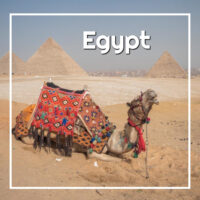Last updated on September 2nd, 2023
Egypt really is awesome. That became clear almost immediately on my 2007 tour that included Cairo and outlying monasteries, Luxor, the Red Sea resorts, and Mount Sinai.

Two weeks in Egypt
A month wouldn’t be enough to see everything Egypt has to offer, but our two-week itinerary was a good way to start.

Tuesday, February 6: The Beginning
I am a little worried as the day gets stated – my fifteen minute trip to the airport takes almost an HOUR.
Usually I wouldn’t worry about this, as I still would have sufficient time to make my flight. However, unlike other tours I’ve been on where the tickets arrive in the mail and everyone meets the tour company representative/guide at the destination airport, our tickets are being held by the company that arranged the tour. This means I couldn’t e-check last night and, now, instead of hurrying to United’s counter to check in, I need to find someone I don’t know named Paul.
How is that going to work?
Since I am the very last one in our group to arrive, finding Paul turns out to be pretty easy – he’s the guy pacing around nervously at the end of a long line at one of United’s counters. I’m sure he’s relieved to check me off his list.
But the check-in line is really long and it is now only an hour before our flight departs. I’m not liking this.
United is handling all of us as a group and has assigned us to one ticket agent for all of us – an agent who is unbelievably slow (it turns out that he is exchanging recipes and fishing stories, which is friendly, but not very efficient). United’s staff has told Paul not to worry. He’s probably worrying even more than me, but I have plenty of worries of my own.
I am here today because Larry Alderink, one of my favorite undergrad professors, is leading this tour. Lane and I had been considering a trip to Egypt last year, but choose Thailand instead.
Shortly thereafter I saw the announcement for this trip. It didn’t work with Lane’s schedule, but he encouraged me to go – telling me I would have so much fun traveling with my former professor and other college alumni that I wouldn’t miss him at all. I alternately believe and doubt that. And now, standing in the airport, I worry both that I will miss the flight and that I will have a miserable time on this trip. Why am I doing this?
Wednesday, February 7: Travel to Cairo
Frankfurt
It isn’t until we are making our approach into Frankfurt, Germany, that I realized I have never actually been to this place that is so important to my brother. It seems like a place I know, but I really only know it through his stories. Someday I’ll have to actually visit here myself.
It was a long flight, but at least it was relatively comfortable, although I couldn’t sleep at all. That is a bummer, but not so surprising considering the fact that my body thinks it is late afternoon (rather than early morning) and I have been consuming copious amounts of Pepsi.
I think of David and Joe ( our LA friends) and how this would have been a far more comfortable way to travel to Asia. When we go to Vietnam ? I’m going to figure out a way we can all get there comfortably – no more scrunched coach seating in China Air!
The Cairo Airport
I can see the pyramids from the plane!
At least I think I can. The sun is so bright that it is hard to see anything, but I really think that is them. If only I can get a little better look. . .
We bank and they vanish from sight.
I don’t have much of a view of Cairo proper as we arrive. What I do see are many, many, huge new developments built in the midst of what appears to be solid desert. At least they aren’t wasting any agricultural land.
The Cairo airport isn’t very big. It reminds me a lot of the airport in Nadi, Fiji, but Cairo is a lot more efficient. If it weren’t for Lufthansa losing a bag or two, we would be moving through pretty quickly.
As it is, we have plenty of time to meet our guide and for me to try to get a better feel for our group. (I was pretty groggy in Frankfurt.) I started this trip not knowing anyone except Larry and, let’s be real, after not having contact with him almost fifteen years, two or three phone calls in the last few months to discuss this trip really isn’t enough to say I know him anymore either. So I am curious about the group with whom I will be spending my time.
It is a big group (31, just like Thailand), with a broad mix of ages, from a young teen to a number of older retirees. There seem to be a fair number who are about my age (give or take ten years). I think this is a good thing. As a group everyone seems friendly enough, but pretty quiet. (Maybe it’s jet-lag.) I’m hoping we gel as well as our Thailand group did.
As we finally gather up our bags, Larry advises us to stop in the airport liquor store if we will want anything during the trip, as liquor stores will otherwise be unavailable. In what I take as a good sign, I have lots of company pursuing the limited wine selection and I begin to get to know David and Rachel as we consider our options. We each buy a bottle or two, deciding we will share our purchases with each other during the trip.
I know now that I will be able to end my days here with a glass of wine and that there will be people to enjoy it with me.
Things are looking better by the minute.
Dinner at Al-Azhar Park in Cairo
We were supposed to stay at the Nile Hilton tonight (in part so we could store our extra luggage there), but Romani has instead booked us into a hotel near the airport. It is a nice place, but is surrounded by the same type of upscale urban sprawl found in California or the Minneapolis suburbs or so many other places around the world. There would be no neighborhood to explore here even if I had the time and energy to do so.
Not that I have energy for anything. I’m actually hungry, but I’m more interested in crashing and sleeping for about three days.
However, Romani has other plans. We must eat dinner and see a bit of Cairo tonight.
Soon I am on a tour bus headed into the city for dinner at a restaurant in a park.
It is dark now and I glimpse the city in bright little flashes.
It looks wonderful, fascinating.
Equally fascinating is the police car that evidently will accompany us everywhere. It seems weird, as the view outside my window looks a lot like any other major city. Do we really need a police escort?
At the park we wind through narrow twisting roads before being dropped off to wander through the park to the restaurant. The distant-seeming city around us glows with lovely, subdued lights. A huge mosque floats above the distant city. We wander through the carefully manicured landscape, past elegant pools, toward a warmly glowing traditional-style building.
It is magical.
It is also very cool – literally. Romani warned us the wind can be cold at night, but hey, I’m from Minnesota, what’s a little cool air?
The cold evening breeze slices through my thin sweater. I am freezing, so am relieved that we are not dining on the patio (despite the beautiful view). Gratefully I enter the relative warmth of the restaurant.
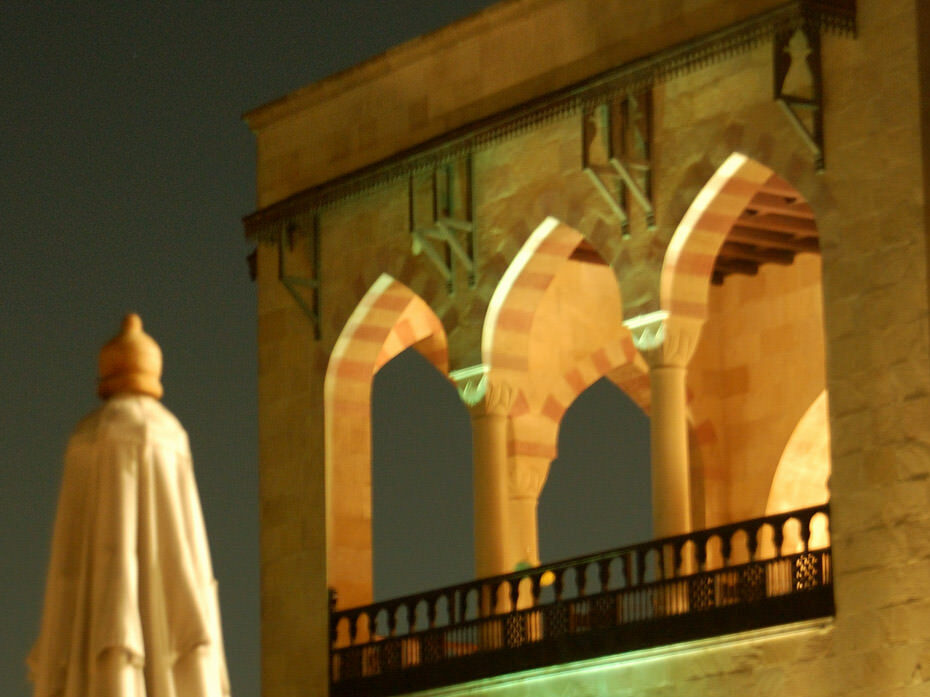
The building is designed to look like a traditional mansion. Despite the grand exterior, it is simple and elegant inside, with clean lines, cool plaster walls, and intricate medieval-looking chandeliers. The wooden furnishings are heavy and over-sized. It all feels very exotic and foreign.
(I will realize the next day that this park is Al-Azhar, which I had read about in the New York Times, but had not expected to see. The restaurant we eat in is either called the Citadel View Studio Misr or the Hilltop Restaurant – all I know this night is that it is beautiful and smells wonderful.)
I end up at one end of a long table, with Romani seated to my left (at the head of the table) and his brother and assistant Isaak to my right. Larry and his wife Lynda are seated across from me. I ask Isaak a few questions, but he is quiet and shy, so mostly I listen while the Alderinks catch up with Romani.
The bread and its accompaniments are wonderful. All of the food is good, but some of the meats are quite rich with lovely, unusual seasonings.
Thursday, February 8: Cairo
The Egyptian Museum
The Egyptian Museum is a great introduction to the history and culture of ancient Egypt, but there is far too much to absorb in one visit!
In Search of the Holy Family
We visit the basement chamber where the Holy Family is said to have stayed on their travels.
The Night Train to Luxor
We arrive at the train station late in the day and then wait on the bus for what seems like a long time.
Apparently the train is running late.
Eventually we are waiting on the outdoor platform as the warm air darkens into dusk. The station lights come on. The trains come and go. Each time we hear another arriving we ask expectantly “Is this it?” as loud announcements in Arabic blare above the din.
At last it is ours and we clamber aboard.
The train is not new, but clean enough and functional. Each small cabin has two bunks and a wash basin. (The shared bathrooms are located at the end of the carriage.) The window opens to the outside, but is streaked with dust and dirt that obscures the view.
I’m exhausted and expected to just fall into bed after boarding. However, nothing makes me feel as if I am embarking on an adventure like train travel does. Maybe that harkens back to my mother taking us all to the cities for Christmas shopping in the last months before passenger service to our small town ended or maybe it stems from all those trains Peter herded us onto all over Europe in college. At any rate, by the time I board I am high on adrenaline. Sitting in my closet of a cabin to eat dinner by myself has zero appeal.
So I stand in the hall, watching out the window and chatting with my fellow passengers. Others also seem equally reluctant to move into their cabin and close the door, so I have plenty of company.

All the of the single rooms in the group have been blocked together, so when dinner arrives, Dave, Nancy, Denise, Rachel, and I all pile into Nancy’s cabin. There really isn’t enough room for all of us, but we order wine through the steward (who seems to find us amusing) and make the space work. We keep the door open and chat with a steady stream of visitors as well as each other while drinking Egyptian wine from plastic cups.
By the time we head off to our cabins for a few hours of sleep we are all good friends.
This is going to be a great trip.
Friday, February 9: Luxor and the Valley of the Kings
Arrival in Luxor
I sleep soundly for awhile, rocked to sleep by the motion of the train, but then I awake in the total darkness of very early morning. I spend the rest of the “night” tossing and turning, worrying that my alarm won’t go off, that I won’t awaken in time to disembark at our anticipated arrival time of 5:30 a.m. I imagine having to spend the day touring Luxor in my nightshirt.
As it is, the train is late arriving in Luxor. This is good, not only because it gives me time to wash, dress, and eat a little of the thoroughly unappetizing breakfast provided, but also because it gives me an hour or so to watch the passing scenery.
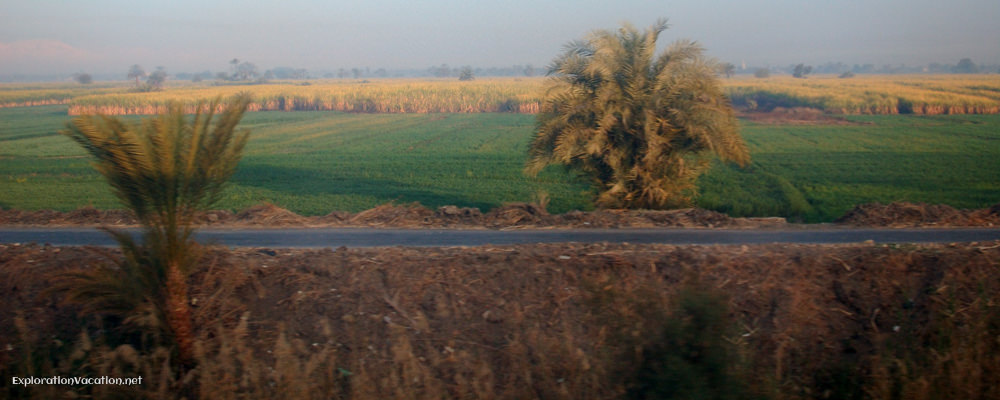
The land through which we are traveling is lush. Palms punctuate carefully tilled fields of emerald green. At this early hour, few people are about, the agricultural workers just now beginning to lead their donkeys in to the green for the day.
Had we arrived on time, we would have missed this in the darkness.
At Luxor station we say goodbye to our helpful steward and then head off into the city.
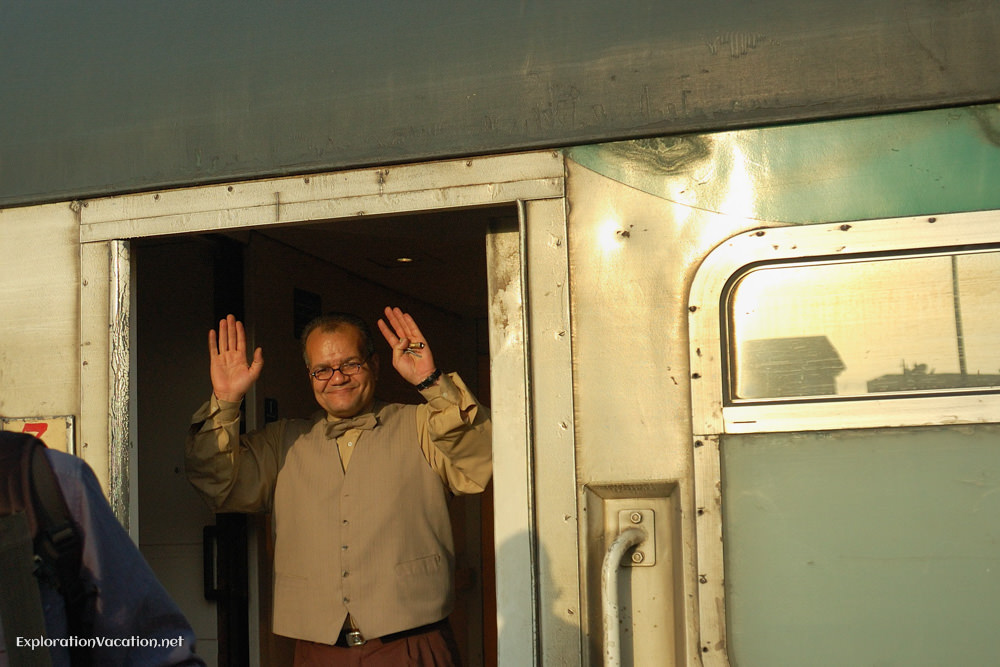
From the bus I can see that the ancient past is thoroughly intermingled with the present here, the new city of Luxor built around – even amid – the ruins of the ancient temple.

Temple of Karnak
Our first stop in Luxor is the grand Temple of Karnak.
Temple of Medinet Habu
A drive across the Nile and through the green fields ends at the colorful Temple of Medinet Habu.
The Colossi of Memnon and Mortuary Temple of Hatshepsut
There’s not much of the Colossi of Memnon, but there are some very dramatic statues (and a few wall paintings) at Hatshepsut’s dramatically sited mortuary temple.
The Alabaster Factory isn’t exactly my thing, but I find a couple things that allow me to join in the shopping frenzy.
The Valley of the Kings
What a desolate place! It is dramatic and beautiful in a way, but also stark and bleak, without a speck of green.

For ancient Egyptians, preservation of the body was essential for eternal life and the west side of the Nile has many, many tombs created to preserve the mortal remains of the elite – the hillsides littered with tombs. All were once hidden from sight, but today the location of many of the major tombs is marked by carefully constructed entrances and directional signage.
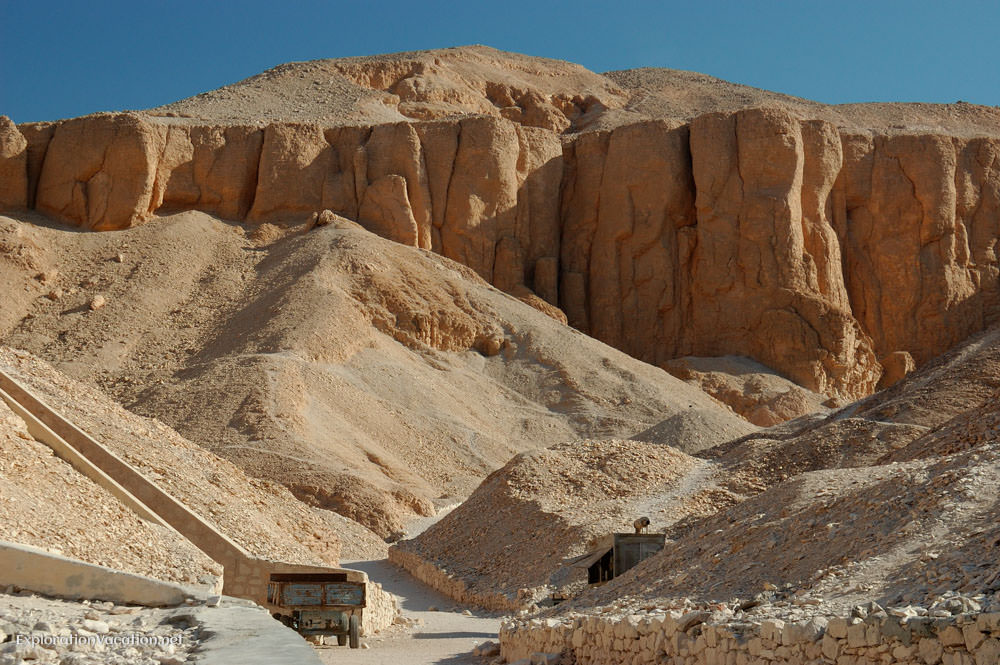
It feels isolated and lonely.
Ramses IV
The first tomb we visit was the burial place of Ramses IV. Outside, Romani tells us this tomb is notable for it’s large sarcophagus. Actually, he tells us a lot more, but most of that information floats away in the hot dry air. All I can think about is what it might be like inside the tomb. I want to see it!
Then we enter.
It is amazing.
Clearly I haven’t read enough about ancient Egypt, as I now realize that I had absolutely no idea what to expect. Of course I’ve seen pictures of tombs with brightly colored paintings, but I guess I never thought that the tombs actually looked like those pictures! How could they? How could something so amazing not only be real, life-size?
We enter this tomb through a very high, broad hallway of sorts. The walls are painted bright white and reflect the small amount of light coming in from outside. I am completely surrounded by brightly painted walls that all but leap to life. The energetic graphics are both beautiful and lively.
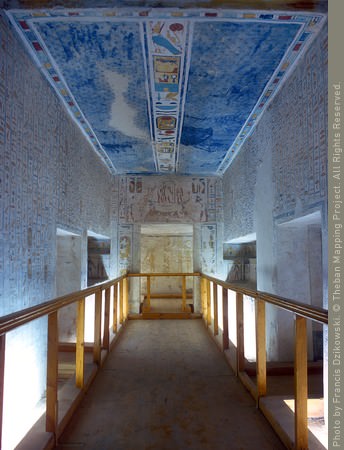
Names and epithets of Rameses IV and sections of the Book of Caverns, photos of tomb interiors by Francis Dzikowski of the Theban Mapping Project
Of course, this tomb, like many others, has been open since ancient times and occasionally I find signs of those past visitors, including Coptic Christians who sometimes hid here to worship.
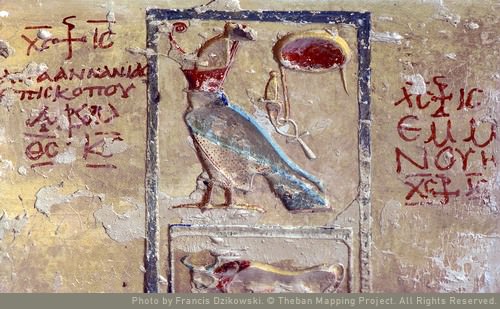
Hieroglyphic text with beginning of Rameses IV’s Horus name, surrounded by Coptic graffiti, photo by Francis Dzikowski of the Theban Mapping Project
The giant sarcophagus is located at the far end of the tomb. It stands in a small chamber that has a beautiful painted ceiling featuring the goddess Nut wrapped around the universe and golden walls with detailed images from the Book of Gates (one of the books of the dead).

Photo by Francis Dzikowski of the Theban Mapping Project

Photo by Francis Dzikowski of the Theban Mapping Project
The elevated walkway that circles the small room is crowded and cramped. The air is suffocating. Time to leave the underworld.
Outside again, the hot dry air feels wonderful.
Ramses IX
The second tomb we visit is that of Ramses IX.
This tomb is a little more complex than that of Ramses IV. However, while some sections are gorgeously detailed, others seem simplistic. It is an intriguing mix.
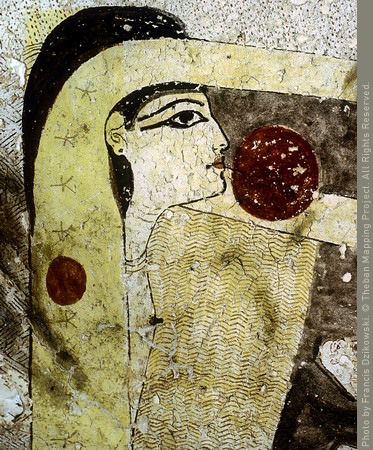
Nut preparing to swallow the sun disk, photo by Francis Dzikowski of the Theban Mapping Project
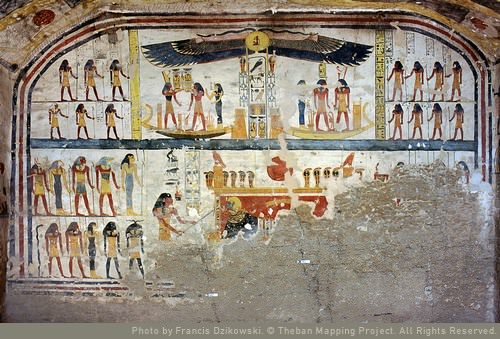
Rear wall of burial chamber, photo by Francis Dzikowski of the Theban Mapping Project
Ramses III
Our final visit is to the tomb of yet another Ramses, in this case, that of Egypt’s last great pharaoh, Ramses III.
Once inside, it is immediately apparent that this is by far the most complex and beautifully decorated of the tombs we have visited.
I love the details here. The designs are so crisp and fresh that I feel as if I have actually entered into some other world.
Every surface is covered – the walls a treasury of images of the king and the gods, lessons for the afterlife, scenes of great sea battles, musicians, household furnishings, and other items both common (jars, weapons, chairs) and exotic (elephant tusks and leopard skins).

Nile god and goddesses representing Heliopolis and Memphis carrying food offerings, photo by Francis Dzikowski of the Theban Mapping Project

Amphorae, photo by Francis Dzikowski of the Theban Mapping Project
However, my very favorite area is the small chamber where I discover a row of cobras fully dressed in Egyptian garb and carrying the symbols of gods and goddesses.

Hu as a cobra wearing a robe and crown, photo by Francis Dzikowski of the Theban Mapping Project
It is where I linger the longest before exiting the tomb and, rather reluctantly, re-entering the world in which I live.
Out in the warm sunshine, I realize I have developed a fondness for these bleak mountains – now that I have been given a glimpse of the splendid world that hides within their barren slopes.
Luxor City
Compared to Cairo, Luxor is a relaxed place. We enjoy it on a cruise on the river and a carriage ride through the city market.
Crossing the Nile
Only two bridges link the west side of Luxor to the city proper, bridges that are clogged with vehicles at this time of day. We are running late after our visit to the West Bank tombs and temples and Romani is looking for a quicker way to get us back into the city. His answer is to send us across the Nile by boat – and by very cheery-looking boats at that.
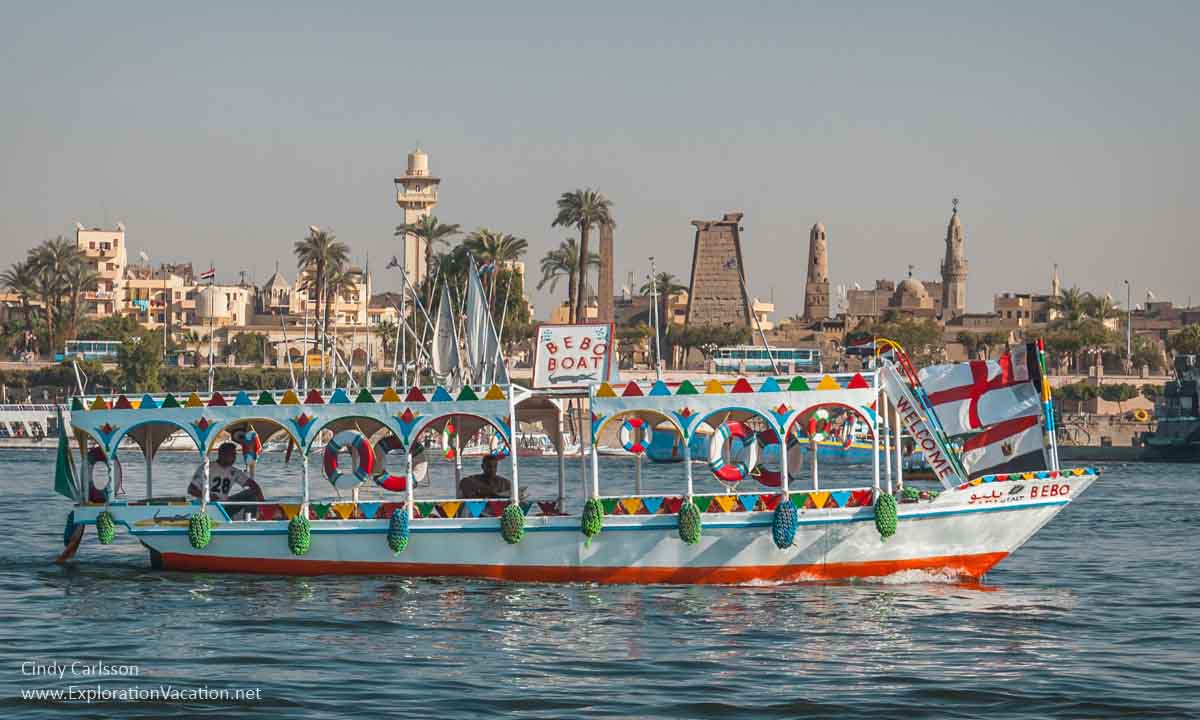

The boats are a little tricky to reach via the sandbag gangplank. . .

. . . but, once aboard, the view is wonderful.


A carriage ride through the city
We are hurrying back because we are supposed to take a carriage tour of the city, but it is already late in the afternoon. Still, not wanting us to miss out, Romani arranges an abbreviated tour.
I share my carriage with Jess, the youngest member of our group. She is an intelligent, curious, and good-humored teenager. I enjoy this chance to hear her take on the trip and on life in general. She is a cool kid.
The carriages make their way through a chaotic market that spills out of the open shop fronts and into the street.
It is a colorful and exotic place.
But the market also feels a bit threatening, which is why I have mixed feelings about the carriage ride. The carriage is a great way to see the market (and even make purchases, as the sellers are happy to pass merchandise up to carriage passengers willing to pass cash back down). From the ground it would be impossible to get a sense of it all – and I think it would quickly become a claustrophobic and slightly menacing whirl of activity and merchandise. I would be intimidated to enter here on foot, but the carriage lifts us above it all, providing both a bird’s eye view and a level of security. On the other hand, we are a dreadful nuisance to those who must work or shop here, forced to maneuver around the carriages in the crowded streets.
I wish we had time to see more of the city, but it is evening now. . . time to thank our driver and return to ground level once again.

We linger for a lovely sunset over the Nile before returning to the bus.

Goodbye, Luxor!
The evening convoy to Hurghada
Travel to the Red Sea is via the evening convoy to Hurghada.
It feels like it is 10 or 11 at night, so I am surprised to find my watch says it is only 8 pm.
What a day!
We are rumbling through the darkness as part of the police-escorted evening convoy to the Red Sea coast. I was able to briefly watch as the green fields of the Nile delta turned to barren sand and rock, but now everything beyond my window has obscured by darkness – the black darkness of night far from urban lighting.
Through the windshield a long line of taillights is visible snaking off into the distance ahead of us.
An equally endless line trails behind us.
We make only one stop along the way, at an official rest area that seems far from any village.
It is a place designed for truck drivers and other weary Egyptian travelers, rather than Western tourists. I like that about it. There are a few stands set near the road with typical tourist items for sale, but inside the stands sell local fast food and the same sort of items you would find at any truck stop in the states. (Although there are also well-stocked shelves filled with British biscuits and candies, which seems a little odd.) Music broadcast through low-quality speakers swells and falls the night air. Scores of cats lie about, some seeking attention, others avoiding it. It all reminds me that I am far from home.
Saturday, February 10: A Red Sea vacation
The Red Sea
We have a full day on the Red Sea, with snorkeling (or diving) in the morning and a beach break in the afternoon.
Sunday, February 11: Traveling to the Sinai
Leaving Makadi to cross the Red Sea
We have been staying at the beautiful Makadi Resort, but today we leave to cross the Red Sea to the Sinai Peninsula.
Crossing to the Sinai
The next phase of our trip begins at the ferry terminal, where we catch the “fast ferry” which will zip us across the Red Sea to Sharm El Sheikh in just 90 minutes.
I understood we were to have our own cabin, but maybe what was meant was simply that we would be in the first class cabin. At any rate, we end up sharing the large cabin with a number of other travelers. Because they are scattered throughout the cabin, there are few window seats left. Boo hoo. A noisy group of us (Carole and Wes, Rachel, and others) pile into a booth where a beautiful young woman had been sitting alone near the window. She buries her nose deeper into her book as we excitedly chatter away around her.
Eventually we become more polite and engage her in conversation. Her name is Sally and she works on a sailing ship. (Which I will look up for future reference, as sailing in the Mediterranean is on my “to do” list!) She has been traveling around Egypt on her own and has been out in the desert, which I quiz her about. It sounds wonderful. Next trip.
Although the ferry has large windows, it is hard to see what we are passing and, unfortunately, passengers are not allowed on deck. (Except for beautiful Sally, for whom the male ferry crew would have done ANYTHING. But she is so sweet it is hard to be jealous of the special access she is given.) I pout a little about the inability to go out on deck, as I hate being unable to watch the scenery passing by – even when the “scenery” is mostly open water.
Romani distracts us with picture books on the Sinai, telling stories and showing us pictures of the places we will soon see for ourselves.
As we arrive in Sharm, I catch a fleeting glimpse of the mountains floating far in the distance like a hazy apparition. It looks so beautiful.
The charm of Sharm
Sharm El Sheikh is the most famous vacation town on the Sinai. I expect it to be an ugly, over-developed place, but Sharm has a charm all its own.
The road to Saint Catherine’s
The road to Saint Catherine’s Monastery takes us through a dramatic, desolate landscape.
Evening at the monastery
We are staying in the monastery’s guesthouse and taking our meals with the monks. I love having a quiet evening in the monastery, but I’m not planning to do the morning camel trip to the top of Mount Sinai.
It is nearly dusk when we arrive at the Monastery of Saint Catherine.
It is beautiful here. Solid stone buildings stand stiffly against the barren mountains, but blossoming fruit trees are just visible in the orchard behind the guesthouse. The fragile blossoms almost glow in the dimming light – an incongruous sight in this rugged setting.
We wait in a courtyard as our luggage is unloaded and room keys distributed. It is cold and seems to get colder every moment as the sun sinks farther and farther from sight behind the mountains.
I am shivering from the cold, but I still wonder: Will I regret not making the trek up Mt. Sinai in the morning? Am I making a mistake?
Before leaving home, I decided that I would skip tomorrow’s pre-dawn excursion up Mount Sinai. Besides the fact that I’m not really much of a morning person (shocking, I’m sure :-), I couldn’t bear the thought of dragging a lot of extra warm clothes along for just one morning. It seemed ridiculous. I mean, it isn’t like Moses will be hanging around up there passing out copies of the Ten Commandments!
But now Nancy says she is going up, taking a camel, and if she gets to the end of the camel path and doesn’t want to continue, she’ll just turn around and take that camel right back down again. I could do that. Well, maybe I could. It is already pretty cold and I REALLY don’t have much warm clothes, but it would only be for a few hours – I could stand being miserable that long, couldn’t I? Wouldn’t it be worth it? Won’t I always regret it if I don’t go?
Perhaps it is fortunate that Lynda is waiting here with me. She points out that she has been to St. Catherine’s before, has never gone up the mountain, and does not feel the least bit bad about it. Her advice: If I am uncertain, don’t go. . . and don’t feel bad about it!
Yay! Thank you, Lynda.
Finally I am given keys and settle into my spartan, but comfortable, little room. It is bone cold when I walk in, but soon the small space heater makes the space warm and cozy.
Although I am hungry, dinner time still seems to come too soon. Back out into the cold.
It is dark now, so the light alone makes the cavernous dinning hall seem warmer than it is. The room has high ceilings with white washed walls that are dominated by several huge black and white photographs – one of which shows the interior of what must be the most beautiful church in the world. I wonder, is it the church we will see inside the monastery?
We are seated together at several long wooden tables, the food served family style. The food is simple, but good and filling. There is relatively little conversation at my table – it has been a long afternoon on the road and I think we are all tired. I eat quickly while the room’s cold damp air seeps into my bones. Brrr. . .
I wait, shivering, desperately wanting to return to my cozy room. However, I don’t want to miss anything interesting either. Larry has promised a brief lecture and evening prayer -something I have been looking forward to. . . but it is so cold in here!
At last Larry begins. It is great to hear him speak (he always was one of my favorite lecturers), but it is also weird. While I HEAR the professor I remember from 20-odd years ago, when I look up the speaker standing before me in this unfamiliar and foreign place doesn’t match my memory of the professor I remember from my small-town college. It makes the experience at once comforting, disquieting, and a little exhilarating. Life is such an interesting and surprising adventure.
Despite the cold, I listen intently. I wish I had a notebook with me. . . who was that he quoted? Did he say, “What’s interesting about people is not what is the same, but what is different.”?
What’s interesting is what is different?
Larry continues on – this is just the opening for the main point he is making, but I am stuck at this spot here. It is the difference between people that is interesting – this is what matters. Is this true? I EXPECT differences, it is the things that are the same across time and culture and how those similarities are expressed that has always interested me. Have I been missing what is significant about the world? Traveling blind, as it were?
I think this is wrong, but I really don’t know what to think.
I’m still pondering it as we recite a few verses to close the day.
I’m still pondering it now.
Monday, February 12: Saint Catherine’s Monastery
Dawn
While the others are trekking to the mountaintop, I enjoy dawn at the monastery and the beginning of a beautiful day deep in the Sinai.
Touring the Saint Catherine’s Monastery
Built in the year 550, Saint Catherine’s Monastery is one of the oldest active Christian monasteries. Our tour takes us through much of this UNESCO World Heritage site, including its library filled with rare books.
Later I have time to walk along the mountainside paths outside the monastery walls, providing wonderful views from the outside looking in.
Tuesday, February 13: Leaving the Sinai
Through the Sinai
We spend most of the day traveling through the Sinai, stopping only to visit a small museum near Saint Catherine’s and the Convent of the Seven Sister in the Feiran Oasis.
Evening from my balcony in Cairo
Our travel speed decreases dramatically when we reach Cairo and it is late when we finally reach the Nile Hilton. But finally I am in my hotel room at the Nile Hilton where I can take in the view of the city and Nile.

Wednesday, February 14:Cairo
Morning Above the Nile
We get to sleep in this morning, which is great.
When I finally get up, I head straight for the windows and pull open the curtains.
Traveling through Cairo
Weaving through the chaotic streets of Cairo provides an overview of the city as we slowly travel through the crowded streets.
Back on the bus, Marvin has Valentine’s candy for each of us. How sweet!
We move slowly through Cairo’s crazy traffic. This looks like a hard city to get around in, with people and traffic all tumbled together in a chaotic jumble.


Actually, the whole city seems to be a chaotic jumble, with buildings old and new crushed against one another, towering minarets standing guard, and a minuscule amount of peaceful green space.






It’s all very interesting.
And then there are the roof tops. . . .
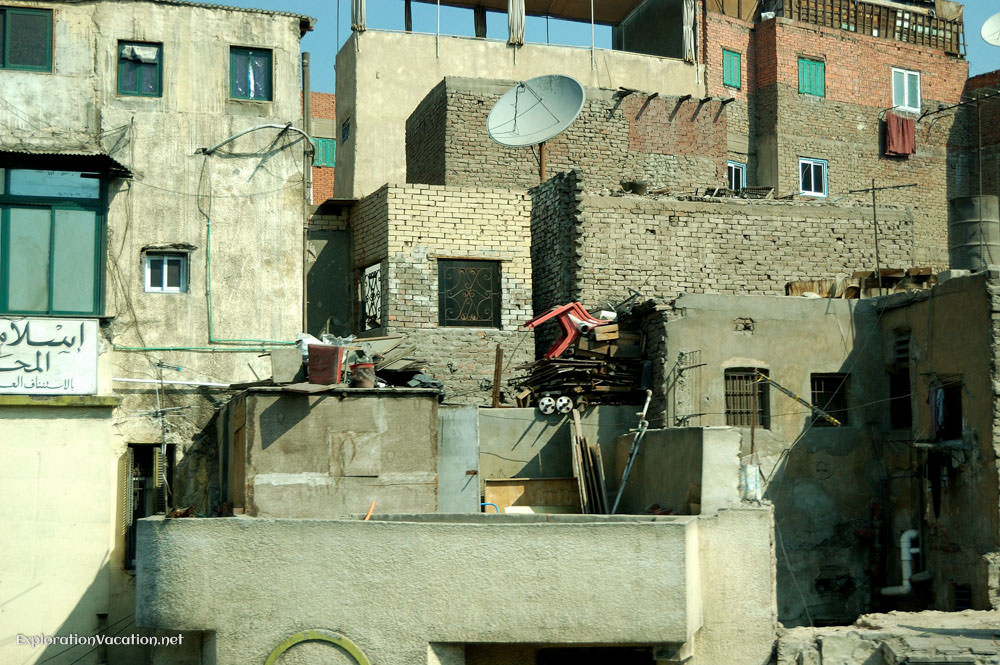
Evidently Egyptians don’t like to throw anything out, so every roof seems to serve as “storage” for items that aren’t wanted, but haven’t really been thrown out either.
Like I said, it is all very interesting.
Sultan Hassan Mosque
We learn a bit about Islam as we tour the Sultan Hassan Mosque.
The Citadel
While the Citadel in Cairo dates back to the 9th century, it wasn’t fortified until the 12th century. It’s huge! But as large as the fortress is, the large, elegant Mohammed Ali (Alabaster) Mosque is the Citadel’s highlight.
Al-Azhar Park
A sprawling park built on a former dump, Cairo’s Al-Azhar Park is the perfect place to enjoy a little greenery and watch the sunset.
Blessings and meditations at the Coptic Cathedral
Every Wednesday the leader of the Coptic church in Egypt holds an evening lecture for the faithful. We are lucky to be here on Ash Wednesday, when the Pope offers his blessing to all. It’s a moving connection to the past. After we have been blessed, the lecture begins. This week it is a meditation on love, since today is also Valentine’s day.
Blessed
It is very late in the day when we arrive at Cairo’s Coptic Cathedral.

We have some time before the evening event begins, so a few of us enter a tiny and much older church located near the Cathedral itself.
It is crowded inside, where groups of people mingle near priests who appear to be taking confessions. It is an intimate space and I am an interloper.
Back outside, we gather together again and head into St. Mark’s Coptic Cathedral.
The Cathedral is a soaring modern building, constructed in the 1960s and very different from the other churches we have seen.
Although I want to gawk at the building, we are quickly herded to the front of the church, where, as directed, I slide into a pew. There is frantic activity all around us, although this vast space is so serene it ALMOST absorbs it. I have no idea what is going on. Cameramen are setting up equipment at the front of the church. Nearby, men scurry around us, dragging wires and cables from place to place. They are all intent on their task, but the sense of excitement is palpable. What is all this about?
What I know: We are here to see (and maybe to meet) the Coptic Pope. How that will unfold is a complete mystery to me.
Probably because it seems self-evident, Romani has not done a particularly good job of explaining that we will be guests at Pope Shenouda III‘s regular Wednesday evening lecture.
Apparently this is a very big deal in Coptic Cairo.
While I wait, watch, and try to guess what will unfold tonight (a worship service? a speech?), technicians are hastily installing plastic strips along the back of the pews where we sit. The tubes must have wiring of inside, because soon we are give headphones to plug into it. When I put a set on, I hear what sounds like a mostly unsuccessful sound test – “Can you hear me? Can you hear me now?” amid dead stillness and loud crackling. Meanwhile, they are still installing strips and pulling out and testing headphones for others in our group. They seem to have gotten a late start on this task. Still, I get the feeling that we are viewed as sort of important guests.
Of course, the frantic activity immediately around me mirrors what is going on in front of us. The huge platform in front of the alter area has ranks of chairs set to either side. One side is rapidly filling with what appear to be priests, monks, and other church hierarchy. The other is filling with more ordinary-looking men and women and even a few children. (Generally Coptic men and women don’t sit together, which makes this all the more intriguing. Who are these people? Lay leaders? Major patrons? I have no clue.) Between the two groups stands a large screen, something that looks like a Bishop’s seat, and a phalanx of cameras, sound equipment, lights, and technicians. It seems informal and rather chaotic.
However, as odd as it sounds, this chaos makes it more comfortable to be here – no one else seems really prepared for whatever is soon to come either.
In the midst of all this – before all the headphones are working or the cameras in place, music begins to swell from somewhere within the church.
Although it doesn’t look as if anything has changed, things must be getting underway.
At last the crowd stirs and then rises. The Pope has entered the room.
Crowds of priests, monks, and others greet the Pope and receive his blessing. The first come in a mob, and then orderly lines form, and then a trickle of individuals. The Pope waits at the front of the church amid the screens and sound equipment and cameras, the lights of the TV cameras trained on him.

It’s as if no one is sure what will happen next.
Suddenly we are told it is our turn – quickly, we must go up and receive a blessing from the Pope.
As I move to the front of the church, I am nervous, excited, and something else harder to define. Perhaps it is a little bit of panic: What is the protocol for being blessed by a Pope? Who am I to be blessed by a Pope anyway? Do I even belong here? What if I screw up in front of all these people?!?
As I stand in front, waiting my turn, I think this is simultaneously one of the most amazing and bizarre situations I’ve found myself in. I offer a silent prayer, await further guidance, and breath a sigh of relief that Jess, the young teen in our group, has been given the honor of going first (pushed to the front of the line – surely the Pope would forgive her for a protocol mistake).
Everything around us seems hurried and confused. We are told to wait, to move, to stop here, to step there, and then to wait again. We are also told that we will shake hands with the Pope, but I don’t believe that. You don’t shake hands with a Pope! Varying information – sometimes contradictory – is hissed at us even as we are moving toward the Pope. I’ll just do whatever Jess and her parents do.
Suddenly I am standing before the Pope. The lights are hot and blinding. . . I don’t have a clue what those ahead of me did. . . . The Pope is seated, so I stoop slightly as he reaches up and, with a cross held in his hand, marks a sign of the cross on my forehead with a firmly-placed finger while pronouncing a blessing. For a moment nothing else exists in the world. I look up directly at him, bow slightly, and whisper “thank you, Father.”
As I step away the chaotic world comes rushing back at me.
I want to capture that moment again and hold it awhile, but it is gone.
Back in my seat, I watch others in our group receive their blessing.
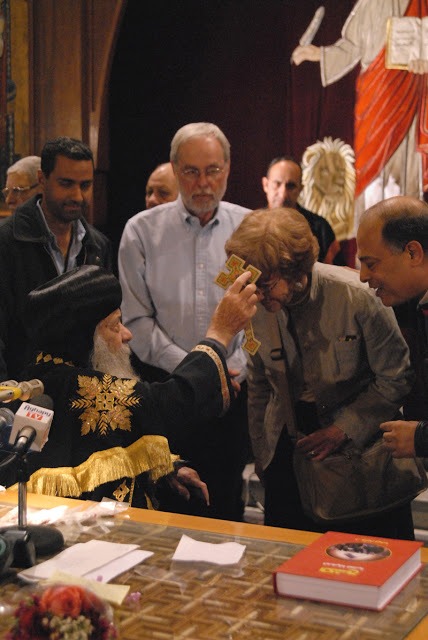
photo by Searle Swedlund
Is this real? Was that really me just a moment ago?
I know it was because I can still feel the shape of the cross on my forehead. I wonder if that mark will prove indelible.
The Wednesday Lecture
On Wednesday evenings Pope Shenouda III answers questions from his flock and then lectures on a point of theology.
It seems like we have been at the Cathedral for hours already and this, the main event, is just now beginning.The Pope rises and stands at a podium, his image enlarged and projected on the large screens above him for all to see.

He welcomes the audience and then begins to sort through a handful of paper – questions submitted to him for his response in a Papal version of the “Dear Abby” newspaper column.
The questions run the gamut from the sanctimonious (“I want to be a priest, but in my heart I fear I am not as worthy as others say I am. . . “) to the slightly silly (“There is this girl in my class and I find it hard to concentrate. . . “). It is Valentine’s Day, so many, many of the questions have a relationship angle. Although we have semi-simultaneous translations delivered directly into our ears, the translator isn’t very good and I miss a lot of what is going on.
Still, I pick up enough to be impressed by the Pope – he is smart, but he also seems to have a sense of humor. He responds to both the sanctimonious and the silly, but with little jabs and jokes that make it clear that the sanctimonious need to get over themselves while the silly should grow up a bit. He tosses aside the questions that don’t interest him – along with some more interesting ones that seem to lead in directions he obviously prefers to avoid. A few get unsatisfyingly pat answers, but he also mulls over a few that seem to truly intrigue him. He also jokes about it being Valentine’s Day.
I wish we would have been able to have a private audience with him.
After some time, he seems to get bored with the questions and brings this part of the evening to a close.
We have a new translator for the Pope’s formal lecture – one who is fast and easy-to-understand. I feel like I’m a member of the UN or something, with the Pope’s words being translated almost as he is speaking them. It’s an odd sensation. I can see (and hear) the Pope speaking and I can clearly here words being delivered directly into my ear, but there is this weird disconnect. It is both disconcerting and very cool at the same time.
But it has been a long day, so, even with a good translator, it is hard to follow the words, let alone their meaning – it is a complicated lecture on the intricacies of Coptic doctrine on the nature of Christ’s divinity. At least, I think that is the topic. I am floating, rather lost, amid the words . . . too ignorant about the topic, too stiff from sitting here, and too tired from a full day of activities to understand very much.
As I increasingly lose track of the Pope’s point, I let my mind wander where it wants while I observe the scene. There are still people moving about in the darkness beyond the Pope’s small illuminated sphere. Even now the chaos seems barely restrained. I wonder what it would be like to attend an audience with the Roman Catholic Pope. I imagine it as unhurried and imperial, very different from tonight.
I think I like the odd casualness of this better.
After the event inside, we learn more about Saint Mark in a small chapel below the main cathedral.
Thursday, February 15: Giza and beyond
Saqqara
Saqqara is the vast area that served as the burial place for Egypt’s earliest rulers. The area includes the step pyramid of Djoser and the tombs of many others, including the beautifully decorated tomb of an official named Mereruka.
Magic Carpets
Carpet shops are rather ubiquitous in this part of Egypt. I have no plans to buy a rug, but the showroom is filled with magic carpets of all colors.
The Pyramids of Giza
We finally get to the great pyramids of Giza, where we gawk at their size, take a short ride on a camel, and admire the Sphinx.
Friday, February 16: Old Cairo
The Coptic Museum
The Coptic Museum holds a large collections of treasures related to Christianity in Egypt.
The Hanging Church
The Hanging Church (El-Muallaqa) was built above a first century Roman fortress. It’s been remodeled a few times, but retains a holy and ancient-feeling interior.
Religious Architecture Galore
A walk through the neighborhood allows us to visit a variety of religious architecture: The Greek Orthodox Church of Saint George, Ben Ezra Synagogue, and the Coptic churches of Saint Barbara and Saints Sergius and Bacchus.
El Azhar Mosque and the Khan El Khalili Market
We split our time between the El Azhar Mosque and the Khan El Khalili Market, because you can only do so much shopping. (And the mosque is historically important and very beautiful)
Saturday, February 17: The Monasteries of Wadi Naturn
Our day takes us into the Western Desert to visit the Christian monasteries of Wadi Naturn. Long a center of Christian monasticism, even today a number of active monasteries remain in the area. We visit three of them:
Wadi Naturn
The monasteries we have been visiting are all located in an area referred to as Wadi Natrun, a low spot in the Western Desert northwest of Cairo where underground water from the Nile supports a series of small lakes. This area was important in Pharaonic Egypt because the naturn found here was used in the mummification process. (Naturn is described as a naturally occurring combination of sodium carbonate and sodium bicarbonate that forms in the lakes, which I think means it is a type of salt.)
It has been an important monastic center since the 4th century.
There is a busy little town here today, with a few fancy modern homes, plenty of small dilapidated structures, and a large variety of modest residential and commercial buildings. However, the area seems to be growing rapidly.
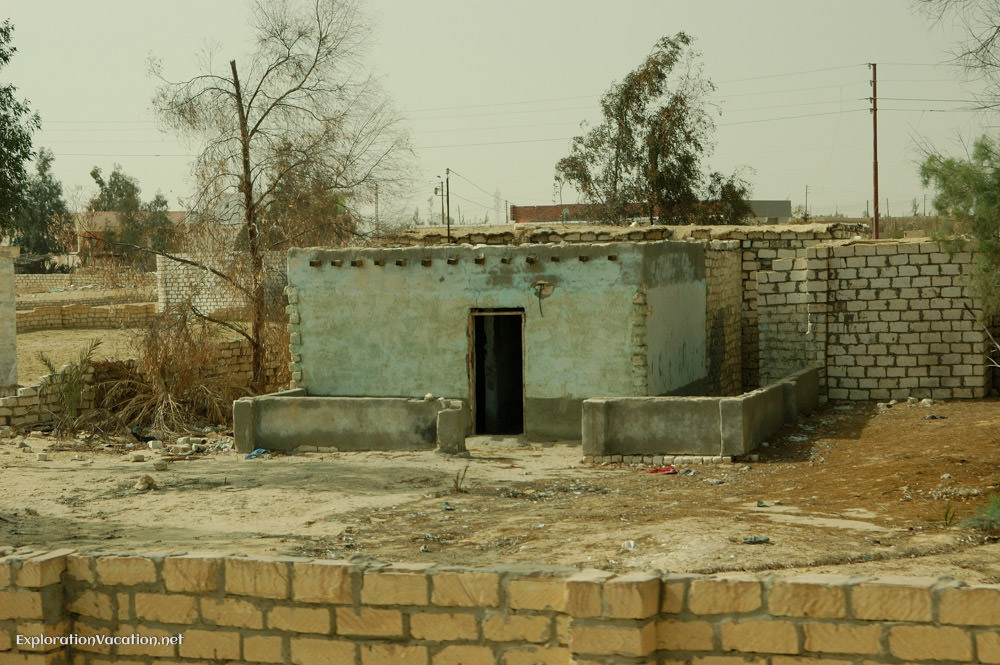



I end the day by meeting a grad school professor who is currently living in Cairo. It really is a small world.
Sunday, February 18: Cairo
Cairo’s Christian Garbage Collectors
Cairo’s Christian Garbage Collectors have a large community hidden in the ancient quarries of Mokattam Mountain. We are here on a Sunday to learn a bit about this community and join in a worship service in one of the community’s enormous cave churches.
On foot in Cairo
After a simple, lovely lunch, we walk back to the hotel. Our security detail drives alongside, always keeping an eye on us, but I’m happy to be out in the city. We’ve had few opportunities to walk here, so it is a treat just to be out in the city’s streets.
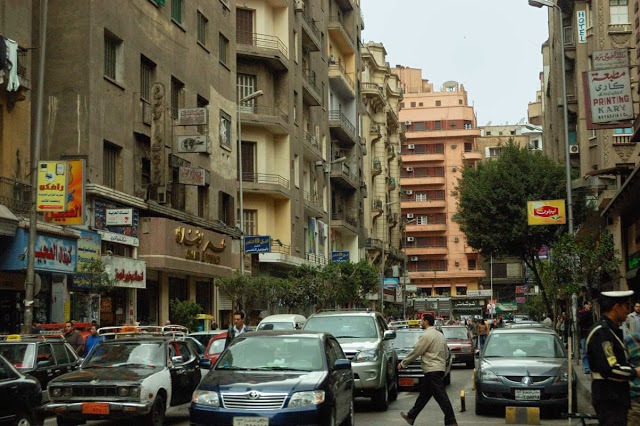
All cities are best encountered on foot!
Cairo: 4 pm
There is still one hour until checkout and I am spending it on my deck, the Nile sprawled out below me and the city’s wonderful cacophony of sound swirling all around.

I love it here.
It seems odd to be leaving – somehow it has come to feel normal to be here and it is odd to think that tomorrow I will be gone and someone else will take my place. It doesn’t seem right.
The end of our time in Egypt
We end our trip to Egypt on a Nile dinner cruise party boat. It’s not the end I would have chosen.
After a few quick errands – including shopping for last minute gifts, I head up to the hotel bar to meet Larry and Lynda and others from our group. We talk some, but the conversation is subdued. Perhaps no one wants to leave.
Not sure what else to do, we wander out to the bar’s patio to watch the sun set as night begins to cloak the city in darkness.

This story should end here, a group of friends reflecting on an amazing trip as night falls over the city. . . but it does not.
Because our flight does not leave until very late, Romani has arranged for us to end our trip at one of the ubiquitous dinner and entertainment barges anchored on the Nile.
The whole thing sounds tacky, but I am hoping for the best.
Inside, the river barge reminds me of the fake luxury paddle wheelers that ply the Mississippi back at home. The whole boat is taken up be a large, glass-walled room with long tables set up around a makeshift stage.
Most of us are seated together at one of these very long tables. It is impossible to talk to anyone except those seated immediately at hand.
It also turns out to be nearly impossible to get a bottle of wine. Not that they don’t serve wine – indeed, the other end of the table has wine – we just can’t get the wait staff to serve my end of the table. I finally make enough of a scene that Romani intervenes and, eventually, we are able to order wine.
And, believe me, I need the wine.
The food is the bland international fare of tourist class hotels worldwide. While not horrible, it is about the most uninspired food we have had on the entire trip.
The less-than-stellar food is accompanied by entertainment so bad it is almost humorous. (If only I had a little better sense of humor.) It begins with a couple of young women (probably Russian). Neither has any discernible talent, but one is clearly out of her element, unable to sing or slither around the stage without looking clumsy. She seems particularly pathetic. They attempt to sing a mix of bad American and European pop songs (John Denver’s Country Roads is among them. I’m sure Muskrat Love is coming) in a variety of languages – none of which they seem proficient in.
While I am appalled and embarrassed for these young women, the large group of Russians seated across the room are clearly delighted. They shout and cheer (and make salacious gestures) between draws on their strong cigarettes. Ugh.
We are also treated to a little interlude of traditional music. I find it delightful. However, I don’t think all of my traveling companions are as fond of the unfamiliar sounds.
The next entertainer is a male dancer who performs a showy whirling dervish type of dance, with over-the-top costuming. While it lacks authenticity, he is a flashy performer and an amazing athlete.

The highlight of the night is, of course, the belly dancer. Let’s just say she is not very good. Ok, so she is really, really bad – and that is before a “wardrobe malfunction” early in the performance sends her running from the stage, her confidence clearly shattered when she later reappears and soldiers on. (A paycheck is good incentive for completing a job no matter how distasteful.) I really want her to be good. I love watching Cassandra perform at home, but now I realize how rare her artistry may be.
We are not allowed outside on the narrow deck that surrounds the dinning area, but I can’t take it any longer and I flee the bad music, worse dancing, and impenetrable cigarette smoke. At the open entrance to the boat, I gulp in both the cool night air and the glorious view of the city slowly passing by.
The Details
This trip was an alumni tour sponsored by Concordia College in Moorhead, Minnesota.
I’ve wanted to go to Egypt for a long time, but the only reason I went now, on this trip, was because Larry Alderink (one of my favorite professors in college) was leading it. That it turned out to be an amazing trip was luck on my part!
Arrangements in Egypt were handled by Romani Gaballa of Egyptian Educational Travel.
Romani is everything you could want in a guide – intelligent, knowledgeable, resourceful, witty, patient, and kind. In addition, Romani’s expertise was occasionally supplemented by that of his brother Issac and fellow tour-guide Osama, both of whom have a deep understanding of Coptic Christian belief, practices, and history.
I plan to return to Egypt with my spouse and a few friends in a couple of years and will definitely work with Romani again. However, at that time I hope to also visit the deserts, sail on the Nile, see Abu Simbel, and add an extension to Petra in Jordan. (Ok, only some of that happened on my 2019 return trip. I did cruise the Nile and see Abu Simbel. But I still haven’t made it to the deserts or Jordan. Someday.)
Safety and security
Most of my friends expressed concern when I announced I was going to Egypt – is it safe?
While we were in Egypt the political situation seemed stable, with no signs of the unrest of a few years earlier (or of the Arab Spring the future held). Whatever one thought of the government’s policies, they kept the county stable and safe for tourism.
None-the-less, there apparently were relatively few American tourists in Egypt in 2007 and we were often met with surprise when people discovered we were American. But we were also met with genuine warmth and friendliness.
Apparently a police escort is required for American tour groups, although it seemed superfluous. I thought it would be off-putting, but our security folks were usually pretty invisible. They could be handy though, as at one point they directed traffic to get the bus backed up and out of a traffic jam!
As we approached the Sinai our escort was supplemented by an armed guard. The police presence in general was more obvious on the Sinai. Still, it seemed a little silly to see our guard, gun tucked in his belt, barefoot, with his pant legs rolled-up, keeping an eye on us at the almost deserted beach on Giftun Island. But, at least we never had to worry about safety — or getting lost.
Getting Around
Within Egypt we traveled by motor coach, mini-bus, train, and ferry. Cairo has a metro system, but we didn’t get to try it out.
Traffic in Cairo
Outside Cairo roads were often nearly empty.

But things were very, very different in and around Cairo.
Traffic in Cairo is truly frightening. It’s the most chaotic of any place I’ve been. (Worse than Bangkok, where there was lots of congestion, but seemingly comprehensible rules of conduct.) There appear to be only a handful of stop lights in the entire city and NO one drives in the marked lanes. It’s utter chaos: Picture a mob pushing its way forward – only it is a mob comprised of cars, trucks, buses, scooters, donkey carts, and pedestrians, some of which might be traveling in the opposite direction.
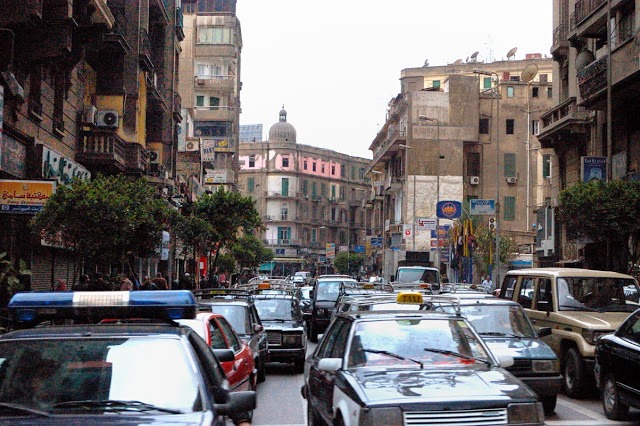
Even after explanations of how it all works, I can’t imagine driving there.
However, the pedestrians were even more shocking: Men, women, and even children simply wade into the sea of erratically moving vehicles. I continually expected to see them mowed over. There is actually a system for crossing the street and, while it isn’t easy or particularly safe, people who live here don’t fear crossing a street on foot nearly as much as actually trying to drive.
Money
Using Egyptian pounds is pretty straightforward and the currency is decorative, which makes smaller notes great souvenirs.
However, keep in mind that there are 50 pound notes and 50 piaster notes, with the physically larger 50 pound note worth $9-$10 US dollars and the piaster worth 9-10 cents. As a friend discovered, tipping the bathroom attendant with a 50 pound note will get you all the toilet paper and soap you could want, but probably isn’t something you want to do on a regular basis.
Tipping
On a day-to-day basis, the biggest hassle I encountered was the seemingly constant demand for baksheesh – a tipping. Tips are expected for even the smallest service (or offer of service, even if you decline). Sometimes it seemed like every person I met was looking for a tip, and sometimes quite loudly.
Egyptians are generally warm and friendly and often they will help without expecting anything in return, but rich tourists (and by virtue of being a tourist, you are rich) are often seen as fair game. So don’t be surprised if you are shown a slight kindness that turns out to be a service for which a tip is expected. If you didn’t ask for the service, just say no, otherwise hand over the tip keep in mind the fact that it isn’t a lot of money.
Like many other places in the world, toilets either require a set fee or payment of a tip. In Egypt the payment is tiny and in most places they actually make some effort to have toilet paper and soap. Just pay up and don’t whine about it.
Photographing people will also often lead to a demand for a tip – even from security officers and park staff. It seems fair to me.

Lodging
Cairo
Most of the time we were in Cairo we stayed at the Nile Hilton (a much older hotel than I would have guessed), which is located near the Egyptian museum. My room was large and pleasant with a good internet connection (but for a fee) and a deck with a splendid view over the Nile. It was great and I would definitely would stay there again.

(In the years since 2007 the old Nile Hilton was reborn as the Ritz-Carlton, but without those wonderful balconies.)
Hurghada
Hurghada has lots of places to stay, most of which totally isolate the visitor from anything related to the local culture.
Our hotel was the Makadi Saraya Resort Painted in cheery Mediterranean colors and swathed in bougainvillea, it was such a lovely, dreamy spot that I really didn’t want to leave it for any reason. (Although the complex is so large and so similar to the adjoining resorts that a friend a got lost and almost missed our snorkel expedition.)

My room was a suite, with a giant bedroom, living and dining rooms, laundry area, and a mini-kitchen. Two large decks overlooked the beautifully maintained grounds.
Sinai
St. Catherine’s Guesthouse is located at the entrance to the monastery. The rooms were simple to the point of being spartan and you have to remember to turn the hot water on before you intend to shower, but they were clean, warm (thanks to space heaters), and comfortable. They also had the advantage of being located in one of the most starkly beautiful places imaginable.
Food and Beverages
Our tour included all meals, which is something I do NOT like because I don’t need that much food, but will eat it anyway. Lunch was usually very late in the afternoon (anywhere between 2-4 p.m.) and dinner was always after 8:00 p.m. and sometimes as late as 10:00. Had dinner not been included, I usually would have skipped it or opted for something light elsewhere.
Having said that, the food itself was excellent.
Breakfast and dinner were usually taken at our hotel. The Nile Hilton and the Makadi Sayara both had exceptional buffets, with delicious Egyptian foods along with well-prepared international cuisine.
Lunches and dinners were generally accompanied by a whole array of starters, with lovely pita breads to scoop up any one of a number of flavorful sauces. I could have easily have had enough to eat just with the starters!
Every restaurant Romani took us to was absolutely wonderful and I wish I had a complete list, but I wasn’t that organized. Here is what I do have:
Eating in Cairo
- Al Azhar Park has a couple of lovely restaurants with very good food.
- Restaurant Andrea had an outdoor eating area that was very pleasant at night. The restaurant specialized in the most amazing grilled chicken over a huge grill. The chicken was beautifully seasoned and perfectly cooked.

- The Sea Horse Club is an Egyptian version of a supper club with huge windows overlooking the Nile and lovely seafood.
- Felfela is an in expensive local chain serving a variety of traditional foods. We ate at the downtown location not far from out hotel. It was an eclectic and sort exotic feeling place with fabulous falafel!
- Sakkara (near the site of the same name) was a touristy place, but pleasant with nice food. (And you could watch them bake the bread.)

Eating other places
Safsafa in Sharm el Sheik was amazing. As described in my post, we had a multi-course seafood lunch that was simply incredible.
We were also had a couple of meals at monasteries, which varied from basic international fare to a simple lunch of bread and olives.
Alcohol
Alcohol is not available in retail shops (outside the airport), but is available by the bottle in most restaurants likely to be frequented by tourists – even in those that also have a local cliental. At least in hotel restaurants, it was possible to buy bottles to take back to our rooms, thus fueling our after dinner soirées. (We usually spent $12-18 for a bottle from a restaurant and took turns buying.) We mostly drank Egyptian wines because they were both widely available and affordable. The whites were pretty bad, so we generally drank reds – most frequently the Obelisk Cabernet Sauvignon or the Gianaclis “Omar el Khayam” Cabernet Sauvignon – neither of which are likely to win any prizes, but which were quite drinkable.
Beer was also generally available in most restaurants.
Shopping
I found shopping to be frustrating.
Like sightseeing, shops that sold anything beyond cheap tourist souvenirs either catered to wealthy connoisseurs or large tourist groups who are given an introduction to a product and then an opportunity to purchase ok quality, but generic items from that company’s stock of rugs, alabaster, papyrus, or even jewelry. The merchandise wasn’t bad, it just wasn’t usually very interesting or unique. Serious shopping for unique local items just wasn’t on the mass tourism radar.
Furthermore, bartering was expected everywhere and, unlike Thailand, where Chris told us at every market how hard to bargain, here I had no idea whether the final price should be 20% less or 80% less. That made bargaining hard – I don’t want to get ripped off, but I don’t want to be insulting either. In the big tourist shops where Romani helped, I usually got the merchant to go at a little lower than the price Romani recommended. Next time I’m going to try to do a lot more advance research on prices because there would be lots of cool things to shop for here!
There were vendors at historic sites and they could be persistent and annoying. However, they seemed pretty benign compared to the nasty and aggressive children working the historic sites in Cambodia. Just say no firmly and keep moving. (Or have some fun listening to their tall tales about the great bargains you are getting and buy a few cheap souvenirs.)
Similarly, in the markets you can expect to be besieged with people trying to sell you everything under the sun if you show even the slightest interest in an object. If you really are just looking, wear dark glasses, keep moving, and don’t touch anything. If you are actually interested in looking at merchandise, be prepared for lots of attention and don’t be afraid to walk away if you really can’t agree on a fair price. However, don’t be a jerk and waste a merchant’s time bargaining over something you have no intention of buying.
If you are on a group tour, you likely will be taken to a variety of specialty shops. In many of these shops, as in many other places outside the United States, as you enter any store you will be given a shopping assistant. While their job is to get you to spend more, they can be helpful in answering questions. And, in most places, they are unavoidable.
Carpet schools
I think every packaged tour visits a carpet school, where rug-making is demonstrated. (Seeing how they wash the rugs in a big concrete tub made me feel much less worried about getting mine dirty from use.) As we left, Romani jokingly thanked us for spending so much, telling us that he will get a much better discount now on carpets for his own new apartment. Of course, that actually is the way it works pretty much everywhere in the world. While I hadn’t planned to buy a rug, I am very pleased with my purchase.
Papyrus institutes
A papyrus institute (like the carpet “schools”, there seem to be a lot of papyrus “institutes” around) will also be on most itineraries. I learned a lot from the quick, but interesting, lecture and demonstration on papyrus. The shop was well-stocked with engaging, affordable work – so affordable that I assumed the images were silk screened onto the papyrus, but no, they are hand painted. (Labor is cheap in Egypt and most images are copied from ancient tomb paintings or scrolls.)
Alabaster shops
An alabaster shop will usually be on the list too, with a carving demonstrated before you shop. If you are on your own, this is one to be very wary of, as the road leading into the Valley of the Kings is lined with brightly painted alabaster shops. They are very picturesque, but they are also damaging nearby tombs. The government was trying to relocate these and shopping there encourages the residents to stay right where they are.
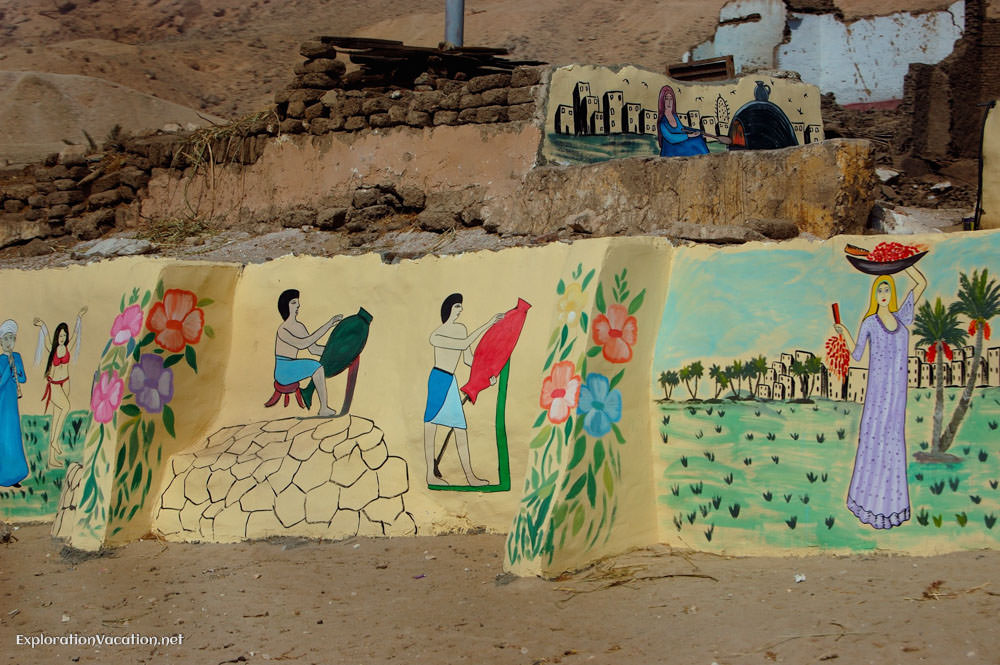
Jewelry stores
Tours may also stop at a jewelry store where you will learn about and have an opportunity to buy a gold cartouche of your name. If not, don’t worry, there are plenty of jewelry shops in the Khan el-Khalili, and every tour stops there.
I wasn’t prepared to buy gold while in Egypt and really wish I had been. The selection was vast, the workmanship exquisite, and the pricing based largely on the value of the gold, rather than on the workmanship. Not buying anything was a mistake.
I really wanted to shop for older jewelry, but had few opportunities to do so. When I did find a selection of older pieces, the prices were MUCH higher than my research had led me to expect and I wasn’t able to bargain them down nearly as far as I would have liked. It appeared that there was much less flexibility in the pricing of previously owned pieces (I suppose since they can’t just make a bunch more of whatever sells best). I did find a few Bedouin pieces and paid a premium for my purchase. (Bedouin jewelry is traditionally melted down when the owner dies and new patterns are valued over old ones, so few older pieces are available and little traditional-style work is being done today.) I also found a few pieces of Persian filigree, which were pretty reasonably priced.

